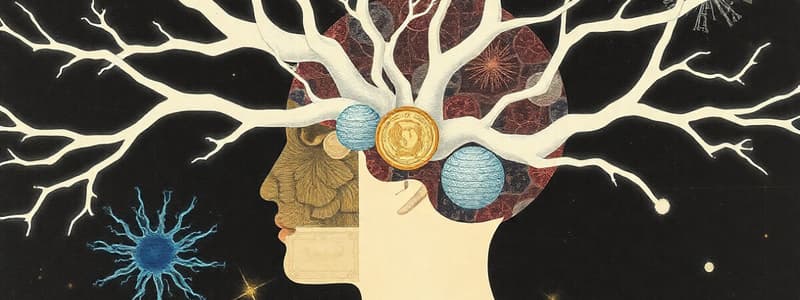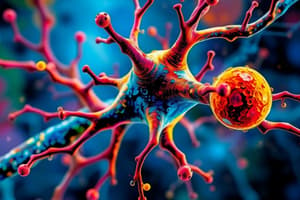Podcast
Questions and Answers
What are the major compartments of a neuron?
What are the major compartments of a neuron?
Dendrites, cell body, axon, axon terminals
What increases the signal speed in myelinated axons?
What increases the signal speed in myelinated axons?
- Diameter of the axon
- Presence of nodes of Ranvier (correct)
- Myelination (correct)
- Ion concentration
What is the function of the Na+/K+ ATPase pump?
What is the function of the Na+/K+ ATPase pump?
Active transport of Na+ out and K+ in
Myelination decreases the speed of action potentials.
Myelination decreases the speed of action potentials.
What is the resting membrane potential?
What is the resting membrane potential?
An action potential is initiated at the ______.
An action potential is initiated at the ______.
Which of the following is a mechanism for neurotransmitter release?
Which of the following is a mechanism for neurotransmitter release?
What is the equilibrium potential?
What is the equilibrium potential?
Match the following ion transport mechanisms:
Match the following ion transport mechanisms:
What types of synapses exist?
What types of synapses exist?
What does a stimulus lead to in the neuronal membrane?
What does a stimulus lead to in the neuronal membrane?
What triggers action potential (AP)?
What triggers action potential (AP)?
Mutations in voltage-gated Na+ and K+ channels in CNS can lead to __________.
Mutations in voltage-gated Na+ and K+ channels in CNS can lead to __________.
What syndrome is associated with a mutation in SCN1A?
What syndrome is associated with a mutation in SCN1A?
What is the primary role of neurotransmitters?
What is the primary role of neurotransmitters?
What type of synapses allow synchronization?
What type of synapses allow synchronization?
Match the following neurotransmitter types with their characteristics:
Match the following neurotransmitter types with their characteristics:
All action potentials are identical in shape.
All action potentials are identical in shape.
What happens when an action potential arrives at an axon terminal?
What happens when an action potential arrives at an axon terminal?
What is the function of SNARE proteins in neurotransmitter release?
What is the function of SNARE proteins in neurotransmitter release?
The fused vesicle membrane is retrieved by __________.
The fused vesicle membrane is retrieved by __________.
Flashcards are hidden until you start studying
Study Notes
Neuronal Structure and Function
- Neurons are the fundamental unit of the nervous system, responsible for transmitting information throughout the body.
- The structure of a neuron is specialized for this function, with key components including:
- Dendrites: Receive signals from other neurons, often with elaborate branching, increasing the complexity of information processing.
- Soma (Cell Body): Houses the nucleus and other organelles, responsible for the neuron's metabolic functions.
- Axon: Transmits signals away from the soma to other neurons or target cells, often covered in myelin for faster signal transmission.
- Axon Hillock: The junction between the soma and axon where action potentials are initiated.
- Axon Terminals: Release neurotransmitters to communicate with other neurons or target cells.
### Neuron Diversity
-
Neurons come in a diverse range of shapes and sizes, with differing structural complexity, particularly in the dendritic tree.
- Multipolar neurons: Possess one axon and multiple dendrites, e.g., Pyramidal neurons in the cerebral cortex and Purkinje neurons in the cerebellum.
- Bipolar neurons: Have one axon and single dendrite, e.g., found in the retina, olfactory bulb, and certain sensory ganglia.
- Pseudomonopolar neurons: Appear to have one process that splits. One branch functions as a dendrite, the other as an axon, e.g., found in dorsal root ganglia of the peripheral nervous system.
- Monopolar neurons: Found in invertebrates, have one process serving both as a dendrite and axon.
-
Myelinated axons have fatty insulation, increasing signal speed and efficiency, crucial for complex behaviors, found in neurons like pyramidal neurons.
-
Unmyelinated axons lack this insulation, resulting in slower conduction speeds, found in, for example, inhibitory interneurons.
Membrane Potential and Ions
- Asymmetric ion distribution: The neuronal membrane maintains an uneven distribution of ions, with higher concentrations of potassium (K+) and chloride (Cl-) inside the cell, and higher sodium (Na+) and calcium (Ca2+) outside.
- Ion pumps and channels maintain this asymmetry:
- Na+/K+ ATPase pump: Actively transports three Na+ ions out of the cell and two K+ ions into the cell, using ATP as energy. Mutations in this pump can lead to neurological disorders like familial hemiplegic migraine and rapid-onset dystonia parkinsonism.
- Ca2+ ATPase pump: Actively transports Ca2+ out of the cell using ATP.
- Na+/Ca2+ exchanger: Transports Ca2+ out of the cell, powered by the inward movement of Na+ down its concentration gradient. Involved in some forms of epilepsy.
- K+/Cl- cotransporter (KCC2): Moves Cl- out of the cell using energy from K+ moving down its concentration gradient. Important for neuronal development.
- Na+-K+-Cl- cotransporter (NKCC1): Transports Cl- into the cell during early development, making chloride channels excitatory in this stage. Alterations in KCC2/NKCC1 ratio are implicated in some epilepsies.
- Leak channels: Allow passive movement of ions across the membrane, contributing to resting membrane potential.
Establishing Membrane Potential
- Equilibrium potential (E): This is the theoretical potential at which there is no net movement of a given ion across the membrane. It is calculated using the Nernst equation, which considers ion concentrations and temperature.
- Resting membrane potential (Vm): This is the electrical potential difference across the neuronal membrane when at rest, typically around -70mV. It is primarily determined by the permeability of the membrane to different ions, with potassium playing a significant role. The Goldman-Hodgkin-Katz equation provides a more complex model for calculating Vm, considering multiple ions and their permeability values..
Action Potential
- Depolarization: A stimulus can cause the membrane to become less negative (depolarization).
- Smaller depolarizations lead to repolarization back to resting potential.
- Larger depolarizations reaching the threshold potential trigger an action potential.
- Action Potential (AP): A rapid and transient reversal of membrane potential, essential for communication between neurons.
- Rising Phase: Driven by rapid influx of sodium ions through voltage-gated sodium channels, causing a sharp depolarization.
- Falling Phase: Potassium ions flow outwards through voltage-gated potassium channels, as sodium channels inactivate, causing repolarization.
- Undershoot: The membrane temporarily hyperpolarizes due to continued potassium efflux, returning eventually to the resting potential.
- Clinical Significance:
- Mutations in voltage-gated Na+, K+, and Ca2+ channels can lead to various neurological conditions, including epilepsy, migraine headaches, and ataxia.
- The discovery of these "channelopathies" has led to the development of drugs targeting specific ion channels for treating various neurological disorders.
- Spike-Initiation Zone: The axon hillock is the primary site of AP initiation in most CNS neurons, though this can differ in sensory receptors.
Action Potential Diversity
- Action potential waveforms can vary significantly in different neurons, due to the diversity of voltage-gated Na+ and K+ channels expressed in the cell.
### Synaptic Transmission
-
Synapse: The junction between two neurons where information transfer occurs.
-
Types of Synapses:
- Chemical Synapse: Communication occurs through the release of neurotransmitters across a synaptic cleft.
- Electrical Synapse: Direct transfer of electrical current through gap junctions allowing for faster and more direct transmission.
-
Chemical Synaptic Transmission:
- Neurotransmitter Release:
- Synaptic vesicles, filled with specific neurotransmitters, are docked at the presynaptic terminal.
- Arrival of an action potential opens voltage-gated calcium channels at the terminal.
- Calcium influx triggers the fusion of synaptic vesicles with the presynaptic membrane, releasing neurotransmitters into the synaptic cleft.
- Neurotransmitter Receptors:
- Neurotransmitters bind to specific receptors on postsynaptic membranes, leading to changes in membrane potential or cellular signaling.
- This binding can be either excitatory (depolarizing) or inhibitory (hyperpolarizing).
- Neurotransmitter Release:
-
Neurotransmitter Diversity: The nervous system utilizes a variety of neurotransmitters, each with different effects and functions.
- Key Neurotransmitters:
- Acetylcholine: Important for muscle contraction and memory.
- Glutamate: The primary excitatory neurotransmitter.
- GABA: The primary inhibitory neurotransmitter.
- Dopamine: Involved in movement, reward, and motivation.
- Serotonin: Affects mood, sleep, and appetite.
- Norepinephrine: Involved in alertness and arousal.
- Key Neurotransmitters:
-
Synaptic Vesicle Cycle: Synaptic vesicles undergo recycling, after releasing their contents, through endocytosis and exocytosis.
-
Clinical Significance: Drugs targeting the synaptic transmission process are used to treat a variety of neurological and mental disorders, including depression, anxiety, and schizophrenia.### Synaptic Transmission
-
Chemical vs. Electrical Synapses:
- Chemical synapses allow for a signed response, signal amplification, and signal computation
- Chemical synapses are well-suited for plasticity and learning
- Electrical synapses are fast, allow for synchronization, and are often bidirectional
- Electrical synapses require less metabolic energy and molecular machinery than chemical synapses
Synaptic Transmission - Diversity of Synaptic Connections
- Axo-dendritic: Axon terminal connects to a dendrite
- Axo-somatic: Axon terminal connects to the cell body
- Axo-axonic: Axon terminal connects to another axon terminal, often modulating the strength of synaptic transmission
- Dendro-dendritic: Dendrite connects to another dendrite, found in the olfactory bulb and involved in lateral inhibition
Chemical Synaptic Transmission
- Steps:
- Synthesize and pack neurotransmitters into synaptic vesicles
- Released by the presynaptic neuron in response to a stimulus
- Neurotransmitter binds to receptors on the postsynaptic neuron, triggering a response
- Neurotransmitter is removed from the synaptic cleft by reuptake or degradation
Major Neurotransmitters
- Types:
- Small-molecule neurotransmitters:
- Glutamate, GABA, and Glycine: Major excitatory and inhibitory neurotransmitters in the CNS
- Monoamines: Long-range diffusing with slow signaling
- Neuropeptides: Diffuse even longer distances, modulate neuronal activity, and are often co-released with other neurotransmitters
- Gas neurotransmitters (e.g., NO)
- Small-molecule neurotransmitters:
Synthesis and Storage of Neurotransmitters
- Locations:
- Glycine and Glutamate: Present in all cells
- GABA and Amines: Synthesized locally in the axon terminal
- Neuropeptides: Synthesized in the rough ER and Golgi apparatus
Synaptic Vesicle Molecular Machinery
- Complex machinery:
- Mobilisation
- Docking and fusing:
- Coating
- Budding
Neurotransmitter Release (Exocytosis)
-
Calcium-dependent release:
- Arrival of an action potential opens voltage-gated calcium channels
- Calcium influx triggers neurotransmitter release
- SNARE proteins (v-SNAREs and t-SNAREs) mediate vesicle fusion with the presynaptic membrane
- Synaptotagmin acts as a calcium sensor on vesicles
-
Speed:
- Fast (microseconds) for small-molecule neurotransmitters
- Slow (milliseconds) for neuropeptides
Synaptic Vesicle Cycle
- Endocytosis and recycling:
- Vesicles are retrieved after fusion
- Vesicle membrane is used to make new vesicles
- Re-formed vesicles are stored in a reserve pool
Clinical Applications
-
Botulism:
- Caused by Clostridium botulinum
- Leads to muscle weakness by disrupting acetylcholine (ACh) release at the neuromuscular junction
- Botulinum toxin cleaves SNARE proteins
-
Tetanus:
- Caused by Clostridium tetani
- Causes tetanic contractions by preventing the release of glycine, an inhibitory neurotransmitter, from spinal interneurons
- Tetanus toxin also cleaves SNARE proteins
-
Latrodectism:
- Caused by black widow spider venom (α-latrotoxin)
- Leads to severe muscle pain and cramping due to massive release of various neurotransmitters (ACh, GABA, norepinephrine)
- α-latrotoxin triggers calcium-independent exocytosis
Neurotransmitter Receptors
- Two main types:
- Transmitter-gated ion channels (direct gating): Neurotransmitter binding directly opens the channel
- G-protein-coupled receptors (indirect gating): Neurotransmitter binding activates a G-protein, which then triggers a downstream signal that indirectly opens the channel
Studying That Suits You
Use AI to generate personalized quizzes and flashcards to suit your learning preferences.




